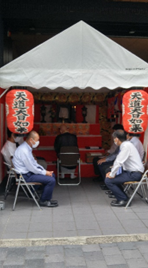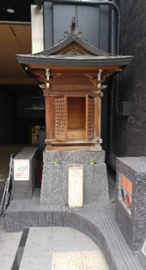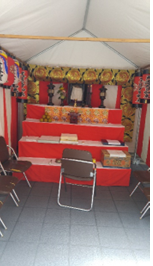Jizo-bon
Yoshie Doi
 |
 |
 |
Shimogyo Ward, Nijohanjikicho Neighborhood Association’s Jizobon August 26, 2022
At the end of summer, Jizobon is held in Kyoto. This is a town event in Kyoto that has been held since the early Edo period. However, in the Edo period, it was called Jizo-e or Jizo-matsuri, and the name Jizobon appeared in literature after the Meiji period. According to information from Kyo-suzume’s staff, Jizo-bon events are held at the end of August in places other than Kyoto. Jizo is enshrined, and although it is not strictly a ritual, it seems that adults and children can enjoy it. I haven’t looked into other areas, but I think it’s done with the idea of the area.
Near the office of Kyosuzume on Karasuma-dori, in Nijohanjiki-cho, Shimogyo-ku, employees of Tamura Co., Ltd., who went to Bukkoji on Karasuma-dori every year, were preparing for Jizobon. Nijo Hanshiki-cho includes the east and west sides of Karasuma-dori, and extends from Ayanokoji-dori to Bukkoji-dori. It seems that there is only one family with children in this erea. Most of them are office buildings, but the Jizobon event continues every year.
In 2022, Jizobon was held from 11 am on August 26th. There is sutra reading, and each one prays. The enshrined Jizo-san is usually enshrined in a small shrine, but on Jizo-bon Day, it is moved from the shrine and placed in the middle of the front of the Jizo-bon tent built on the same site.
This Jizobon festival in Nijohanjikicho continues to be held on the Tamura Corporation site. It is a long-established store that has been in business for over 150 years. Unlike other regions, Kyoto has been formed as a community town since the Heian period. Ujiko of Inari Shrine south of Gojo Street, Ujiko of Gion Shrine from Nijo Oji to Gojo Oji, and Goryo Shrine Ujiko north of Nijo
The parishioners of the shrine (now Kamigorisa and Shimogoryosha) were a bunch.
From the point of view of the local community, the sense of community in the town made Jizobon a lively event, and it seems that both adults and children enjoyed it during the Edo period. 36-year-old Bakin is depicted in Takizawa (Kyokutei) Bakin’s “Kiryomanroku” (Kyokutei) Bakin (Kyowa 3rd year, 1803). I am writing about Kyoto.
In Kyoto, there was a town rule from the end of the Muromachi period, and it is written that the cost of this Jizobon was paid from the membership fee in the town. It is surprising that such a system has been established since the Edo period. I feel the latent power of the Kyotsuzuri people that events like this that are passed down to the next generation are held every year in the business district of Rakuchu.
The end of document
